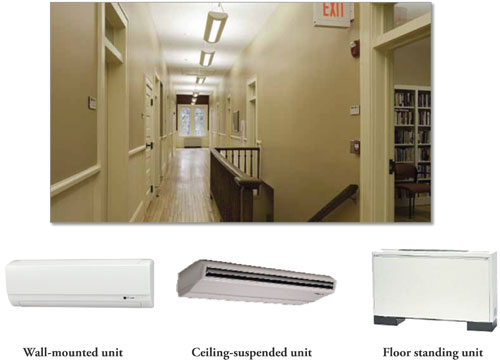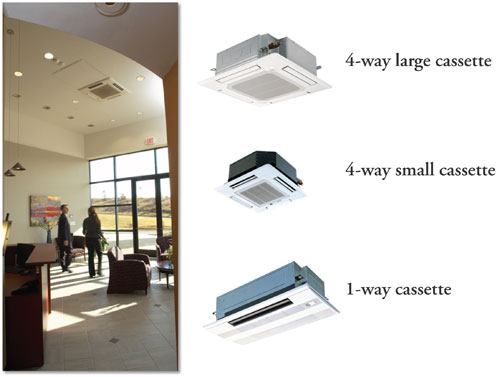Cool VRF Technology
Ventilation
In hot and humid climates or in situations where there are high occupancy zones, a separate ventilation system may be required. Some major manufacturers offer outside air processing and indoor units that can mix in ventilation air.
Lighter in weight
VRF systems are lighter than chilled water systems. They also cost less to transport. Based on standard manufacturer data, the average equipment weight per ton for a VRF outdoor unit is 70 lbs per ton; the average equipment weight per ton for water-cooled chiller is 101 lbs/ton. The VRF system, thus, shows a 31 percent equipment weight reduction when compared with a water cooled chiller. This can effect a significant reduction in additional structural cost.
Moreover, due to the modular nature of VRF, the load can be distributed across the existing structure, or even avoided by mounting on the ground. Rather than having to find space and structure for a large chilled water system or rooftop unit, the VRF system can fit into smaller spaces and be hidden more easily. This reduces point loads on the building and the possible need for additional structural support.
Lower life cycle costs
Depending on the design and needs of a building, VRF and split systems can have fewer components than other HVAC systems, reducing initial equipment costs. Installation costs for VRF and split systems would therefore be smaller–fewer components mean less time spent on installation, and lengths of small-diameter refrigerant piping are easier to install than lengths of ductwork.
According to manufacturers, VRF and split system indoor and outdoor units are robust, have a life expectancy of 15 to 20 years, and require significantly less maintenance than other systems. Many other systems require retro-commissioning and constant maintenance to preserve their installed efficiency, but VRF technology has the logic built in. VRF system performance is constantly being modified to maximize performance and comfort during its normal operations; changing or cleaning the filters is the only required periodic maintenance.
Specification Choices
Since VRF modular technology presents design professionals with multiple possibilities, some manufacturers are offering training and support. "In the past two years alone about 20,000 people have gone through our training on ductless and VRF systems," reports Meredith Emmerich, Mitsubishi Electric Cooling & Heating's senior director of application support.
Specifiers also have multiple options. All indoor units are available in a variety of styles. Ductless wall-mounted, ceiling-suspended and floor-mounted units are options for spaces where ceilings are exposed. These units provide efficient comfort to spaces without detracting from the existing architecture with large pipes or ductwork running along the ceiling. The floor-mounted unit also has the capability of being installed in a millwork enclosure allowing the unit to further blend in with the architectural design.
 |
Traditional systems require roof tops and mechanical rooms for equipment and ductwork. VRF systems leave space for green roofs and more usable building square footage. Images courtesy of Mitsubishi Electric |
Options for ducted units include vertical units and low profile horizontal medium and high static units.
 |
Examples of ductless indoor units. Images courtesy of Mitsubishi Electric |
Compact ceiling-recessed cassette units may be specified for lay-in ceilings. In four-way units the auto fan speed feature automatically adjusts the fan speed based on the difference in set temperature and room temperature. A one-way or single direction airflow cassette may be used for combating excessive heat from a window, or in a small office area.
 |
Compact ceiling-recessed cassette units for lay-in ceilings help reduce plenum space requirements. Images courtesy of Mitsubishi Electric |
Ceiling cassettes, ceiling-suspended, horizontal- and vertical-ducted units and floor-mounted units may all have the capability of accepting ventilation air. The cassette and space mounted models provide a knockout to introduce ventilation air. The ducted models can mix ventilation air into the return air system. The ability to accept ventilation air ensures that the VRF system will provide a high level of indoor air quality as well as comfort control.
As with any new technology, a lack of familiarity and history of documentation will always raise questions. In response, the American Society of Heating, Refrigerating and Air-Conditioning Engineers (ASHRAE) has assembled a group to study VRF and develop documentation. In its 2008 handbook, the association included a description of VRF systems and expects to publish a separate chapter on VRF in 2012.









